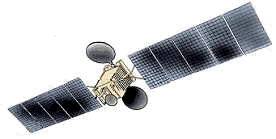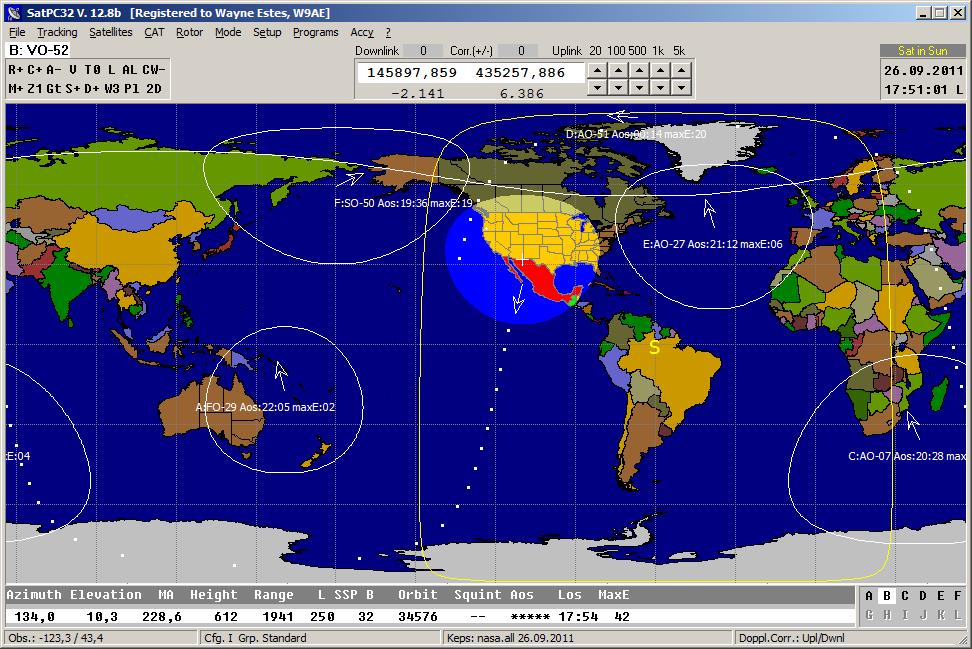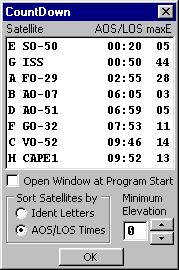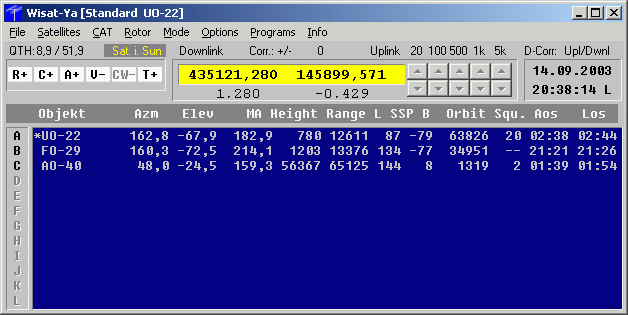

This
page contains descriptions of the most important of my programs for
satellite tracking and antenna and radio control. Click on the corresponding
links to display screenshots
Further detailed descriptions and illustrations
can be found on the AMSAT-DL
website.
The SatPC32 program package includes the following programs
SatPC32, SatPC32ISS and Wisat32,
WinAOS
WinListen
SuM, SuMListen
The programs are available in German and English versions.
They can be obtained on CD
or via Internet download.
Since I support the work of
AMSAT with my programs, they are distributed
A fully functioning demo version of
the SatPC32 package (German or English) with only one little restriction
vs. the full version can be downloaded from the page Downloads or from the website of
AMSAT-DL Warenvertrieb
(Shop).
After registration the demo can be switched to full version. The program
itself contains all informations how to register.
European users can order the program (CD or registration code) at AMSAT-DL Warenvertrieb, Northamerican users at Amsat-NA (see section "AMSAT Catalog , software" on their website), users in Great Britain (shortly) at AMSAT-UK.
The program DDESat32 (full version) is free and can be downloaded also from the page Downloads.
![]()

Screenshot of FO-29.
The distandce between 2 points of the the ground track correspondents to a 2-minute time interval. FO-29 allows SSB and CW contacts on 2m uplink/ 70cm downlink. When you select the satellite SatPC32 will automatically set the proper uplink and dowlink frequencies and modes. While the satellite is in range you will immediately hear your signal with the right audio pitch. You don't need to tune arround to find your signal as you would have to do without automatic frequency control. During the pass you can tune around the passband with the VFO like in terrestrial operation and no corrections due to the Doppler shift changes will be necessary.

The "Countdown" window allows to quickly overview the next satellite passes (the window should be positioned outside the SatPC32 main
window).

The screenshot shows the main window of Wisat32
More
Screenshots:
SatPC32
ServerKCT
![]()
The
programs SatPC32.Exe (in the following: SatPC) and Wisat32.Exe (in the
following: Wisat) calculate the tracks of earth orbiting satellites.
The calculations are based on the SGP4/SDP4 model, the results therefore are highly
accurate. Both
programs are included in the SatPC32 program package.
SatPC32ISS.Exe (in the following SatPCISS) is a special version of SatPC32
for radio amateur operation via the ISS. The program provides "In-Band" frequency control with several
radios. While "normal" amateur satellites use different bands for uplink and downlink both frequencies of the ISS are in the 2m band. The
"normal" SatPC32 switches the radios into satellite mode to allow full
duplex operation (transmitting
and receiving at the same time). Therefore uplink and downlink must be in different bands.
SatPC32ISS
is also included in the SatPC32 program package.
SatPC displays the audibility-areas of one or several selected
satellites within a world-map and shows the results in text-lines below
the map. Wisat represents the satellite positions in real-time in list-form.
Both programs update their calculations continuously in steps of one second. The differences
between SatPC and Wisat result from the absence of the graphic output in Wisat.
The
automatic Doppler correction also works with
ssb transponders like FO-20, FO-29, AO-10, AO-40.
The antenna-control steers the AMSAT Rotor Interface and the ready-appliance
IF-100.
Further, the following interfaces and controllers are supported:
RIF-PC ( Orbitronic) ,
WinRotor32 (Funkbox ,Parallel port and USB version),
ARS (EA4TX ),
HalloRotor ( DB3DH),
Fodtrack-Interface (XQ2FOD),
Kansas
City Tracker /Tuner (KCT/T),
Yaesu GS-232 and compatible interfaces (G6LVB-Tracker, AlfaSpid, DL7AOT, CX6DD,
ST3 (FoxDelta), SatDrive),
SAEBRTrackBox (N8MH),
Satellite Tracker Mini, Junior, Senior (W0LMD),
SatEL interface (Satellite Electronics),
Egis-Rotoren,
Labjack U12 (USB Controller / PiggyBack (NLSA),
Labjack U3 (USB Controller, see page 'Downloads'),
LVB Tracker,
AlfaSpid controller,
ST1 controller (VU2FD),
Pro.Sis.Tel.controller (see page
'Downloads'),
M2/RC-2800 (only
azimuth rotor)
Driver programs for these devices are included (or are delivered with the
hardware), which take the data for
rotor- and CAT control via DDE from the main-programs SatPC32 and
Wisat32. At the end of this section you will find as
an exemple a screen copy of the driver-program for the KCT (ServerKCT.Exe).
The frequency- and mode-control works with the following radios:
Yaesu transceivers FT-736R,
FT-847, FT-817, FT-857 and FT-897,
Kenwood transceivers TS-790E/A and TS-2000,
ICOM transceivers IC-820, IC-821, IC-910H und IC-9100,
ICOM receivers and transmitters, that work with the same cat protocol (i.e.
IC-275, IC-475).
The programs will work also with serveral other models, this has to be tested, however.
In Vfo mode the radios supported by SatPC32 (except the Yaesu
FT-736R, s. below) can be tuned with the Vfo as well as via the PC
mouse and keyboard in selectable frequency-steps of 20, 100, 500 Hz, 1 KHz and 5 KHz.
The Yaesu
FT-736R can be tuned only via the PC as described above. Since it's Vfo
frequency can not be read, it can not be tuned with the Vfo knob.
The output of
the CAT control is sent directly to a (physical or "virtual") serial
port (it can also be sent to the KCT Tuner thus the radio can be steered
via the serial ports of the KCT/Tuner).
Further, the program provides a constantly active DDE interface, which allows third-party-programs to receive the antenna positions, frequencies and modes calculated by SatPC32. This interface -in example - can be used by CX6DD's WispDDE. Thus all hardware supported by WispDDE can be controlled also by SatPC32.
A particular interface allows cooperation with Uni_Trac 3000. Therefore all hardware supported by that program can be steered with SatPC32, too ( beyond the devices supported by SatPC32 itself).
The programs support the
125% and 150% fonts of the newer Windows versions. There are several window
sizes selectable, depending on the resolution of the graphic card and the
monitor.
The programs can show times in UTC or alternatively in the observer's local time.
Downloads:
A fully functioning demo of the current version of SatPC32 (English and German versions) with
only
one little restriction vs. the full version can be downloaded from the page Downloads. You can register the demo version at AMSAT-DL, Northamerican users at AMSAT-NA and users in Great Britain (shortly) at AMSAT-UK.
After registration you get a password, that switches the program to full version.
On the page Downloads you can also download the complete manual of the current version
of SatPC32 and Wisat32 (English and German) as HTML-File or as an illustrated PDF file.
The
program is included in the SatPC32 package, too.
The
program reads source files, that contain Keplerian data in the AMSAT -
The lists show the rising and setting times of the satellites, the duration of audibility, the maximum elevation in the pass and the azimut angles at rising and setting times.
WinAOS (12 K)
The
program is included in the SatPC32 package, too.
The
program reads source files, that contain Keplerian data in the AMSAT -
Corresponding
to the selected function the program displays
1. all positions,
2. positions of positive elevation (window),
3. start and finish times of the window,
4. windows for 2 observers,
5. start and finish time of this window.
The program can be run alternatively in UTC
or in the observers local time.
The following screenshot shows the output window of the program.
WinListen (10 K).
The program also displays whether the satellite is eclipsed or not
DDESat32
is an interface program, that only works with Wisp32 and only in the SatPC32
environment, because it reads some of the auxiliary files of SatPC32, when it
starts.
The program takes the output of GSC (azimut, elevation, ma-value, up- and downlink frequencies and modes) and converts it to the protocol of the connected rotor- and cat-interfaces and outputs it to the hardware. The program supports the same radios and rotor interfaces as SatPC32 and Wisat32 do, see above.
DDESat32
runs under Windows 95/98/ME, WinNT 4.0, Windows 2000 and Windows XP.
As far as I know DDESat32 is (besides SatPC32 and Wisat32) the only 32-bit application that provides rotor-control with the IF-100 and RifPC and rotor- and cat-control with the KCT under WinNT 4.0, Windows 2000 and Windows XP at this time.
DDESat32 (8 K)
5. SuM, SuMListen
SuM (for "Sonne und Mond" =
"Sun and Moon") is a non-graphical program that calculates the
positions of the sun and moon with high accuracy. It uses special routines that
do not require Keplerian data. The program controls also the antennas and can be
used to verify the antenna directions by tracking the sun or moon.
SuMListen
calculates
the
positions
of
the sun
and
moon,
and outputs the
results
to
a list on
the
screen or
printer
or
saves
them
to
a
file.
SuM, SuMListen (40 K)
![]()
Home Links Downloads Gallery DK1TB